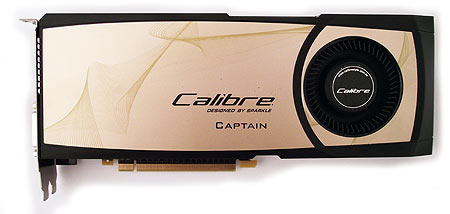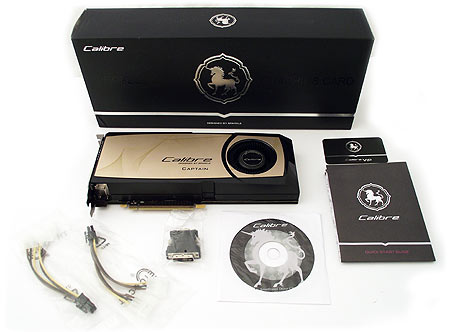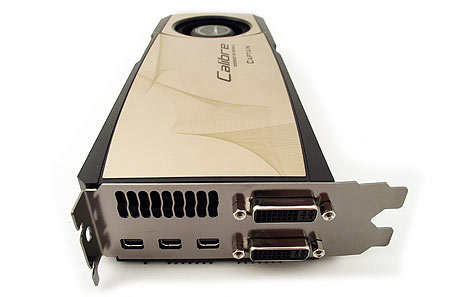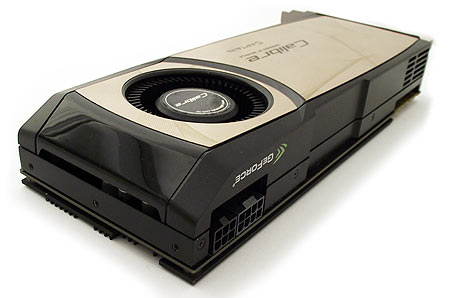Four Overclocked GeForce GTX 580 Cards, Rounded Up
Today we put four factory-overclocked GeForce GTX 580 cards to the test: Gigabyte’s GeForce GTX 580 Super Overclock, MSI’s N580GTX Twin Frozr II/OC, Calibre’s X580 Captain, and Zotac’s GeForce GTX 580 AMP²! Edition. Which one is worth its premium price?
Calibre X580 Captain
This product's efforts aren't limited to pure overclocking performance. The X580 Captain is marketed under Sparkle’s Calibre brand, suggesting a focus on luxury and professional use. Equipped with an 822 MHz core and 1008 memory frequency, the Captain is certainly no reference-clocked model. It doesn't break any speed records either, though.
What is does have is Calibre's Maxwide technology that enables three- and four-monitor display configurations. Before we dig into that, let's take a look at the card itself.
At first glance, it'd be easy to assume that the X580 Captain is a reference GeForce GTX 580. Indeed, the cooler appears identical to Nvidia’s design, featuring a single radial fan and vapor chamber.
Measuring 11” long, the PCB is based on Nvidia’s creation. But Calibre's product does have some unique attributes. For example, the company claims there will be a 3072 MB version in the future (our sample comes with the standard 1536 MB of GDDR5). The side of the board has voltage measurement points exposed to serious overclockers, and the back side is covered with a metal panel that provides sturdiness and acts as a heatsink to keep the card cooler. The X580 Captain also features tantalum and decoupling capacitors. While these improvements are nice, this card’s reference cooler is going to have a tough time competing with the impressive aftermarket solutions used by the rest of the products in this round-up.
The bundle includes a Molex-to-six-pin PCIe power cable, a Molex-to-eight-pin PCIe power cable, a DVI-to-VGA converter, a driver CD, a manual, and a Calibre VIP membership card that purportedly gives owners access to special support from Sparkle.
The board comes with a three-year warranty.
Get Tom's Hardware's best news and in-depth reviews, straight to your inbox.
More than anywhere else, the rear I/O bezel is where the Captain differentiates itself from the competition; it sports two DVI outputs, in addition to three mini-DisplayPort connectors. Enter Calibre's Maxwide technology, allowing the card to handle up to four displays. Up until now, Nvidia's products have suffered a tremendous disadvantage to AMD's Eyefinity technology in that they couldn't accommodate any more than two monitors per card, and in order to use Nvidia’s Surround feature, you needed at least two cards in SLI. Calibre's X580 Captain circumvents that limitation.
Unfortunately, Maxwide is still held back by some of its own caveats. In order to use three or four displays, only one can be attached to a DVI output. The remaining displays must be attached to the mini-DisplayPort outputs. We asked Sparkle, Nvidia, and IDT for more information on the technical details behind Maxwide, but only Sparkle answered our questions. In light of that unfortunately weak responsiveness from the other firms, here's what we know:
The GF110 GPU includes two independent display pipelines, which is why most boards include multiple outputs, but only allow two operate simultaneously. One of the chip's outputs remains unaltered. However, Sparkle attaches IDT's VM1300 ViewXpand multi-monitor controller to the other one, taking a single DisplayPort input and turning it into a trio of DisplayPort outputs. The main limitation there is one of resolution. IDT supports the following combinations:
| Number of Screens | Screen Size | Cumulative Resolution |
|---|---|---|
| Two | 24" | 3840x1200 |
| Three | 22" | 3840x1200 |
| Two | 23" | 4096x1152 |
| Three | 18.5" | 5464x768 |
Of course, you can add to that one additional display via a dual-link DVI port. The question is whether attaching two 1920x1200 screens through DisplayPort and and one through DVI gives you two or three separate surfaces? We didn't have the DisplayPort-capable monitors in our Canadian lab to test, and IDT's documentation makes us think that everything attached to the VM1300 is a single surface. Calibre confirmed that the three DisplayPort outputs are treated as a single monitor, so triple-head gaming requires three monitors attached to those outputs; you can't split a game between the DisplayPort and DVI outputs. That'd seem to incredibly inconvenient, coupled with a third 1920x1200 screen. And maybe that's why nobody else has taken IDT's more than two-year-old controller to create a GeForce GTX 580 capable of more than two simultaneous display outputs.
Equipped with 1536 MB of GDDR5 memory, this card has a $649 MSRP, which is $100 more than the second-most expensive card in our roundup and only $80 short of a GeForce GTX 590. Although Calibre claims it's available, neither this model nor the upcoming 3072 MB version can be found for sale anywhere in the U.S., making this more of an exhibition in our round-up than a serious contender.
Overclocking
Calibre doesn’t include an overclocking utility with the X580 Captain, so we’re using MSI’s Afterburner. The utility’s GPU voltage adjustment feature works with this card, fortunately, and is able to push the stock 1.03 V to 1.15 V. As always, we increase the card’s fan speed to maximum in order to normalize our overclocking efforts at the highest possible level.
While the reference cooler is almost intolerably loud at this setting, it remains effective, and we are able to take the core to 960 MHz and the memory to 1100 MHz during the FurMark stress test. Given FurMark's inability to represent real-world games, however, we had to drop the core clock to 940 MHz in order to achieve stability during a Crysis 2 benchmark.
Current page: Calibre X580 Captain
Prev Page MSI N580GTX Twin Frozr II/OC Next Page Zotac GeForce GTX 580 AMP²! EditionDon Woligroski was a former senior hardware editor for Tom's Hardware. He has covered a wide range of PC hardware topics, including CPUs, GPUs, system building, and emerging technologies.
-
Hupiscratch Great article. Some ASUS boards would be nice on a next round up. And also that MARS card, with two GTX 580 in one board.Reply -
mayankleoboy1 +1 to include a ASUS DCII card.Reply
reason for MSI's faster performance : faster memory?
-
asmodyus What I don't understand is why you did not use the MSI lighting Extreme with an 832 core clock it would be a better contender in your shoot out here than the twin razor since your using the Zotac 3GB version. Does not really make since when you think of overclocked GTX 580 to leave that card out.Reply -
hardcore_gamer Two GTX570s cost only $580. It is a way better option than an overclocked GTX580 imo.Reply -
more memory is very handy for gpu based renderer like Mentalray's iray of Chaos group vray RT and it may be better chose over many nvidia quadro card.Reply
-
verbalizer +2 for the ASUS DC cards, they should have had one of those models in the line-up.Reply
though there is a triple slot 580 from ASUS that should also be included.
with all the talk on how the 590 is the 'flagship' card or the 'meat and potatoes',
it's the 580 that really brings home the bacon..





